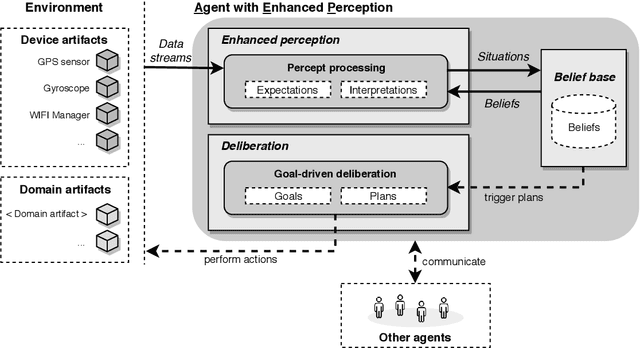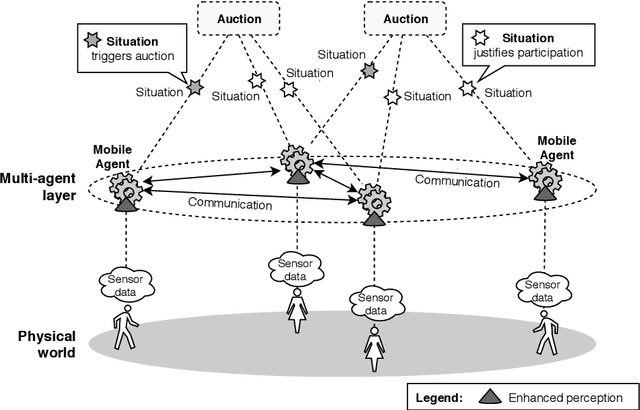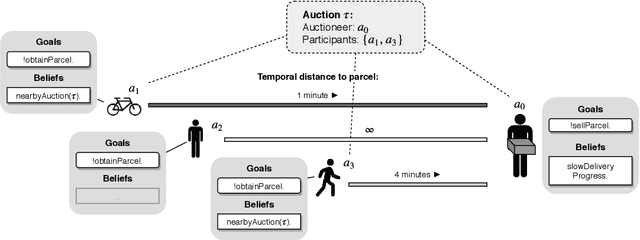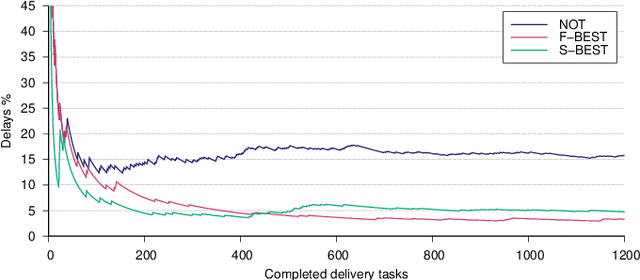Jeremias Dötterl
Stream-based perception for cognitive agents in mobile ecosystems
Jan 24, 2024



Abstract:Cognitive agent abstractions can help to engineer intelligent systems across mobile devices. On smartphones, the data obtained from onboard sensors can give valuable insights into the user's current situation. Unfortunately, today's cognitive agent frameworks cannot cope well with the challenging characteristics of sensor data. Sensor data is located on a low abstraction level and the individual data elements are not meaningful when observed in isolation. In contrast, cognitive agents operate on high-level percepts and lack the means to effectively detect complex spatio-temporal patterns in sequences of multiple percepts. In this paper, we present a stream-based perception approach that enables the agents to perceive meaningful situations in low-level sensor data streams. We present a crowdshipping case study where autonomous, self-interested agents collaborate to deliver parcels to their destinations. We show how situations derived from smartphone sensor data can trigger and guide auctions, which the agents use to reach agreements. Experiments with real smartphone data demonstrate the benefits of stream-based agent perception.
Evaluating Collaborative and Autonomous Agents in Data-Stream-Supported Coordination of Mobile Crowdsourcing
Jan 23, 2024Abstract:Mobile crowdsourcing refers to systems where the completion of tasks necessarily requires physical movement of crowdworkers in an on-demand workforce. Evidence suggests that in such systems, tasks often get assigned to crowdworkers who struggle to complete those tasks successfully, resulting in high failure rates and low service quality. A promising solution to ensure higher quality of service is to continuously adapt the assignment and respond to failure-causing events by transferring tasks to better-suited workers who use different routes or vehicles. However, implementing task transfers in mobile crowdsourcing is difficult because workers are autonomous and may reject transfer requests. Moreover, task outcomes are uncertain and need to be predicted. In this paper, we propose different mechanisms to achieve outcome prediction and task coordination in mobile crowdsourcing. First, we analyze different data stream learning approaches for the prediction of task outcomes. Second, based on the suggested prediction model, we propose and evaluate two different approaches for task coordination with different degrees of autonomy: an opportunistic approach for crowdshipping with collaborative, but non-autonomous workers, and a market-based model with autonomous workers for crowdsensing.
On-Time Delivery in Crowdshipping Systems: An Agent-Based Approach Using Streaming Data
Jan 22, 2024



Abstract:In parcel delivery, the "last mile" from the parcel hub to the customer is costly, especially for time-sensitive delivery tasks that have to be completed within hours after arrival. Recently, crowdshipping has attracted increased attention as a new alternative to traditional delivery modes. In crowdshipping, private citizens ("the crowd") perform short detours in their daily lives to contribute to parcel delivery in exchange for small incentives. However, achieving desirable crowd behavior is challenging as the crowd is highly dynamic and consists of autonomous, self-interested individuals. Leveraging crowdshipping for time-sensitive deliveries remains an open challenge. In this paper, we present an agent-based approach to on-time parcel delivery with crowds. Our system performs data stream processing on the couriers' smartphone sensor data to predict delivery delays. Whenever a delay is predicted, the system attempts to forge an agreement for transferring the parcel from the current deliverer to a more promising courier nearby. Our experiments show that through accurate delay predictions and purposeful task transfers many delays can be prevented that would occur without our approach.
Classification of Home Network Problems with Transformers
Dec 03, 2023Abstract:We propose a classifier that can identify ten common home network problems based on the raw textual output of networking tools such as ping, dig, and ip. Our deep learning model uses an encoder-only transformer architecture with a particular pre-tokenizer that we propose for splitting the tool output into token sequences. The use of transformers distinguishes our approach from related work on network problem classification, which still primarily relies on non-deep-learning methods. Our model achieves high accuracy in our experiments, demonstrating the high potential of transformer-based problem classification for the home network.
 Add to Chrome
Add to Chrome Add to Firefox
Add to Firefox Add to Edge
Add to Edge